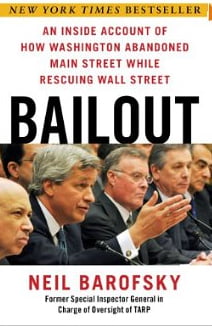Beware: the purpose of this book is to infuriate you.
Bailout is a scathing remonstrance of the mishandling of the Troubled Assets Relief Program (TARP). The author, Neil Barofsky, headed the Office of the Special Inspector General for TARP (SIGTARP) from late 2008 to early 2011. SIGTARP’s duties: audit the distribution and use of TARP funds, prosecute TARP-related fraud and report the findings to the public.
It’s the stuff of blockbuster legal thrillers: plucky young investigators unearth the billion-dollar misdeeds of financial giants, and uncover a vast government conspiracy. It sounds sensationalist, but it’s not far from the truth. Through Barofsky’s compelling, accessible narrative, Bailout details SIGTARP’s struggle to force banks to explain how their billion-dollar TARP handouts were being spent.
Initially, TARP was sold to the public as a means of stabilizing the banking system and providing relief to homeowners. But SIGTARP’s repeated calls for transparency and accountability were thwarted by government officials shilling for the mega-banks. As Barofsky grimly observes, “The revolving door between [the U.S. Treasury Department] and the giant investment funds and banks just never stops spinning.”
As the chronicle unfolds, Barofsky gets increasingly caustic with regulators. Where, he wanted to know, was the help for homeowners TARP promised? What he got in response was the deeply flawed Home Affordable Modification Program (HAMP). Bailout exposes HAMP’s poorly planned servicing incentives and its politically-motivated goal structure. In one of several notable exchanges, a frustrated SIGTARP deputy skewers the Treasury over its announcement that HAMP is a success because it has offered loan mods to millions of homeowners. “If you make 4 million [loan modification] offers but the offers are so bad or the program is so poorly run that only three people accept, would you then say that the program had met its goals?”
Later, Barofsky neatly summarizes the hypocrisy of the government in refusing to offer principal reductions for distressed home owners. “[It was] beyond ironic that [the] Treasury was now emphasizing moral hazard with respect to home owners…The same government that had already jumped into the deep end of the moral hazard pool when it came to bank executives was now using the same concept as an excuse not to use TARP to help struggling home owners.”
Besides the engrossing story, Bailout offers the reader a valuable primer on the regulatory failures necessitating TARP. Explanations of mortgage-backed securities, tranches, collateralized debt obligations and credit default swaps are provided in plain English. And, more importantly, explanations are given context. These faulty investment vehicles did not appear out of thin air. No; there were years and years of systemic behind-the-scenes regulatory failures leading up the crisis.
And that’s the warning Barofsky leaves with readers. The system is broken. The manhandling of TARP and HAMP were inevitable, because the regulators “[drink] the Wall Street Kool-Aid”. Even the unprecedented consumer protections offered by the Dodd-Frank Act are flawed since they perpetuate the existence of the mega-banks. If mega-banks are permitted to write their own ticket for being too-big-to-fail, if they continue to hold the puppet strings over their regulators, if they are allowed to thrive on failure at the public’s expense, the next bailout will be even more massive than this last one.
Read Bailout. You’ll walk away enlightened, and angry. And sometimes, it’s important to be angry.















hamp is a joke! I got a mod. all they did was add the 2 payments that i was behine, to the back of the loan. Payments stayed the same. Im 2 mo.s behine again. The banks wants me to do a short sale. I would lose the house so some investor can buy it for a low price. Why dont the banks offer just reduce the principal, its the same thing.
Just the kind of reporting I like to see. Oh lord it gets disheartening being reminded about “the rich vs everyone else” and hearing more proof about their intentional deceit to keep every penny they have and steal as much from others as possible. And, to hear once again, that our own government officials lie to us makes me feel like crap. It seems like there is no way to win and defeat those evil doers. Where is our leader? Who will step up for “everyone else” and lead the middle class to make the rich sorry for their behavior? Who will come forth and organize us to take all our money out of big banks and put it small local banks? Who will come forth and organize us to not buy BP gasoline? Who will come forth and organize us to stop buying useless drugs? And the revolution could go on and on. It sure would feel good to see some fat cats squeal uncle for a change and go a few days without food.
It is definitely good to be angry….that stops the sheeple mentality.
Good article Ms Burdette.